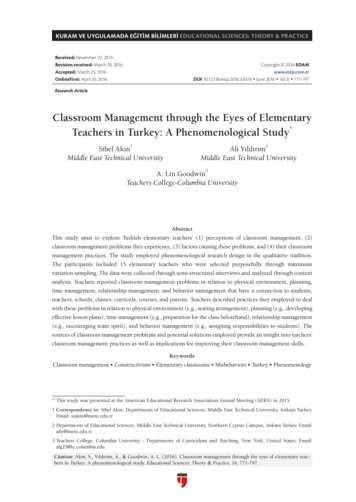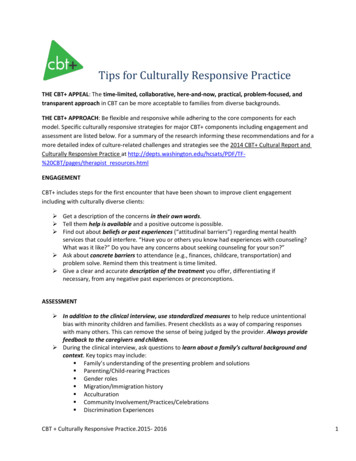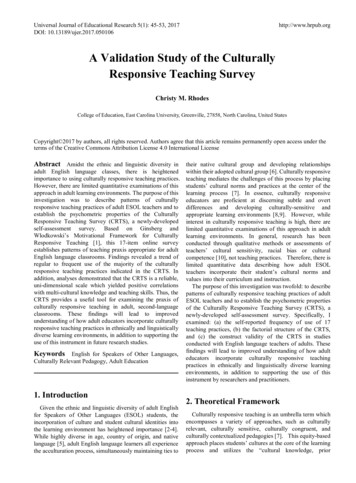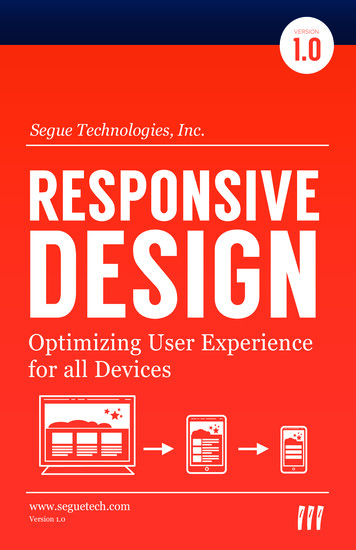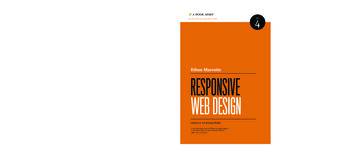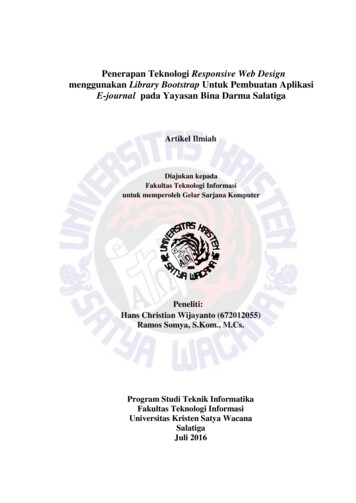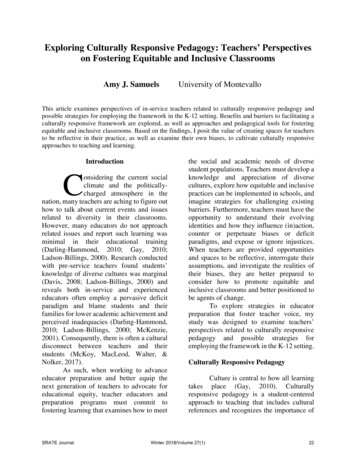
Transcription
Exploring Culturally Responsive Pedagogy: Teachers’ Perspectiveson Fostering Equitable and Inclusive ClassroomsAmy J. SamuelsUniversity of MontevalloThis article examines perspectives of in-service teachers related to culturally responsive pedagogy andpossible strategies for employing the framework in the K-12 setting. Benefits and barriers to facilitating aculturally responsive framework are explored, as well as approaches and pedagogical tools for fosteringequitable and inclusive classrooms. Based on the findings, I posit the value of creating spaces for teachersto be reflective in their practice, as well as examine their own biases, to cultivate culturally responsiveapproaches to teaching and learning.IntroductionConsidering the current socialclimate and the politicallycharged atmosphere in thenation, many teachers are aching to figure outhow to talk about current events and issuesrelated to diversity in their classrooms.However, many educators do not approachrelated issues and report such learning wasminimal in their educational training(Darling-Hammond, 2010; Gay, 2010;Ladson-Billings, 2000). Research conductedwith pre-service teachers found students’knowledge of diverse cultures was marginal(Davis, 2008; Ladson-Billings, 2000) andreveals both in-service and experiencededucators often employ a pervasive deficitparadigm and blame students and theirfamilies for lower academic achievement andperceived inadequacies (Darling-Hammond,2010; Ladson-Billings, 2000; McKenzie,2001). Consequently, there is often a culturaldisconnect between teachers and theirstudents (McKoy, MacLeod, Walter, &Nolker, 2017).As such, when working to advanceeducator preparation and better equip thenext generation of teachers to advocate foreducational equity, teacher educators andpreparation programs must commit tofostering learning that examines how to meetSRATE Journalthe social and academic needs of diversestudent populations. Teachers must develop aknowledge and appreciation of diversecultures, explore how equitable and inclusivepractices can be implemented in schools, andimagine strategies for challenging existingbarriers. Furthermore, teachers must have theopportunity to understand their evolvingidentities and how they influence (in)action,counter or perpetuate biases or deficitparadigms, and expose or ignore injustices.When teachers are provided opportunitiesand spaces to be reflective, interrogate theirassumptions, and investigate the realities oftheir biases, they are better prepared toconsider how to promote equitable andinclusive classrooms and better positioned tobe agents of change.To explore strategies in educatorpreparation that foster teacher voice, mystudy was designed to examine teachers’perspectives related to culturally responsivepedagogy and possible strategies foremploying the framework in the K-12 setting.Culturally Responsive PedagogyCulture is central to how all learningtakes place (Gay, 2010). Culturallyresponsive pedagogy is a student-centeredapproach to teaching that includes culturalreferences and recognizes the importance ofWinter 2018/Volume 27(1)22
students’culturalbackgroundsandexperiences in all aspects of learning(Ladson-Billings, 1995). The approach ismeant to promote engagement, enrichment,and achievement of all students by embracinga wealth of diversity, identifying andnurturing students’ cultural strengths, andvalidating students’ lived experiences andtheir place in the world (Villegas & Lucas,2007). Culturally responsive pedagogy ischaracterized by teachers who are committedto cultural competence, establish highexpectations, and position themselves as bothfacilitators and learners.Overview of the StudyThis qualitative study sought to exploreperceptions on culturally responsive teachingof K-12 in-service teachers serving in lowsocioeconomic schools in a large urbanschool district in the southeast region of theUnited States. I collected data fromapproximately 200 teachers over a fourmonth period. Participants engaged in smallfocus groups of four to five to explorecharacteristics of culturally responsiveteaching as highlighted by Villegas andLucas (2007): (1) understanding how learnersconstruct knowledge, (2) learning aboutstudents’ lives, (3) being socio-culturallyconscious, (4) holding affirming views aboutdiversity, (5) using diverse instructionalstrategies, and (6) advocating for all students.The purpose of the research was two-fold.While my primary goal was to contribute andinspire increased dialogue related toperspectives of culturally responsiveteaching of currently practicing teachers, thesecondary aim was to create spaces foreducation professionals to engage indiscussion regarding how to best foster thisframework in the K-12 context.Teachers volunteered to attend a six-hourprofessional development session dividedinto two three-hour sessions. The primarySRATE Journalpurpose of the first session was for teachersto build a foundational understanding ofculturalresponsivenessandrelatedcomponents. The facilitator led participantsthrough a thorough presentation aboutcultural responsiveness as both a theoreticalframework and a pedagogical practice. Whilethere are strategies and teaching approachesaligned with cultural responsiveness, thefacilitator emphasized the need forpractitioners to view this approach as anattitude that becomes part of the classroomclimate and culture. Culturally responsiveteaching cannot be viewed as a separate unitof study or a stand-alone lesson, but rather anapproach and attitude that is fostered inoverall teaching.The second session served primarily as afocus group. Applying their foundationalknowledge of what they learned in sessionone, participants were asked to read currentliterature and engage in discourse about whatcultural responsiveness looks, sounds, andfeels like in the classroom. Participants weregiven time to carefully read and individuallyreflect on the theoretical framework andprovided characteristics of culturallyresponsive teaching as presented by Villegasand Lucas (2007). After individuallyreflecting, participants engaged in focusedsmall-group dialogue about how thecharacteristics could be generally interpretedand applied in the K-12 setting. Participantswere heterogeneously assembled so bothelementary and secondary teachers wererepresented in each group. In theircollaborations, participants were also askedto consider real-world examples of how thecharacteristics could be best applied orfacilitated in their current contexts. Teacherswere given the opportunity to exploreperceived advantages, as well as challenges,of employing a culturally responsiveframework in their professional practice.Participants. Participants in the studyexhibited an interest in the topic andWinter 2018/Volume 27(1)23
voluntarily registered to attend an in-servicesession on the topic of culturally responsiveteaching. Attendance and participation wasstrictly voluntary on the part of the teachers.Participants were currently in-service andserving in low socioeconomic K-12 schoolsin the same large urban school district. Whilemost participants were teachers in elementarysettings (approximately 60 percent), 40percent of participants were middle and highschool teachers who represented variouscontent areas. Teaching experience of theparticipants spanned a large continuum andrepresented teachers from less than one yearto those with over twenty years ofexperience. In addition, participantsrepresented a mix of female and male, as wellas Black, Hispanic, and White. Specifically,70 percent of participants were female while30 percent were male. In relation to racialcomposition of the participant group,approximately 55 percent were White, 40percent were Black, and 5 percent wereHispanic.Data Collection and Analysis. Icollected and analyzed data from thecommunicationsItranscribedfromparticipants in the focus groups, as well as myobservations of the focus group dialogue andrelated notes. Participants recorded theirbeliefs about benefits and challenges offacilitating culturally responsive pedagogy,as well as their perceived understandings andviable application of the framework. Ingroups, participants were asked to clarify andexpand upon their written ideas, specificallyadding detail to teaching practices andpedagogical tools that can be employed tofacilitate culturally responsive practice.Once I collected the data, I employedcoding procedures to determine themes fromtranscripts and my observation notes. Tomove from the raw data to conceptualthemes, I employed Rubin and Rubin’s(2005) steps of interview data analysis. Thedata analysis process involved: 1)SRATE Journalrecognition, 2) examination, 3) coding, 4)sorting, and 5) synthesis. Recognition,examination, and coding involved preparingthe data. Sorting and synthesis involvedanalyzing the data. Recognition entailed theprocess of reading, reviewing, and studyingthe transcripts and notes to determineconceptualthemesimportantforunderstanding the research. Examinationinvolved carefully exploring concepts andthemes to clarify meaning and understanding.Coding called for designating and employinga system of color-coded highlighting toreadily retrieve and examine conceptualthemes across the interviews based on 1)interpretation of the characteristics ofculturally responsive teaching, 2) applicationof culturally responsive teaching, 3)perceived benefits, and 4) naltiesregardingteachers’perspectives on culturally responsivepedagogy, including perceived dfacilitationofculturallyresponsive teaching beneficial in a multitudeof areas, restraints of time and resources wereheavily emphasized. Findings also examinedhow to integrate theory and research intopracticetoimpactdecision-makingcommitted to academic success andoutcomes for all students, especially studentsfrom historically-marginalized populations.Advantages of Culturally ResponsiveTeachingParticipants considered facilitation ofculturally responsive teaching beneficial inrelationship building, fostering cross-culturalunderstanding and inclusiveness, andinfluencing more diverse world views.Participants spoke extensively about howcultural responsiveness has the potential topositively influence classroom culture, fosterWinter 2018/Volume 27(1)24
positive relationships, and build a solidrelationship of trust. They spoke about howthese components not only encouragestudents to feel connected, included, andvalued, but lead to empowerment on behalfof students, helping them better understandand positively view both themselves andothers; thereby inspiring them to maintaincultural identity and integrity. In addition, thepositive classroom culture and ps serve to boost student selfesteem and self-worth which results inincreased confidence and sense of safety inthe classroom. It creates an environmentwhere students are willing to share and takerisks and establishes a classroom culturewhere students are willing to take off theirmasks (Kafele, 2013) and imagine newpossibilities, particularly in relation tolearning, access, and opportunities. In aclassroom where culturally responsivepedagogy is practiced, bridges are built thatconnect students, teachers, schools, andcommunity.Extending beyond soft skills and socialemotional skills, participants highlighted thepotential for students to develop increasedopen-mindedness and expanded worldviewsthrough participation in dialogue andengagement in constructivist and/orcollaborative learning. Participants spokeextensively about how culturally responsiveteachers serve as facilitators (as opposed to“sages on the stage”); therefore, there isincreased accountability on students and theirrole in the learning process. In a culturallyresponsive classroom, students learn bydoing; thus, student engagement is enhanced.Such engagement consequently results inincreased student learning and achievement.In addition, dialogue associated withsociocultural consciousness and diversityawareness is embraced. Students are giventhe opportunity to let their voices be heardand engage in conversations related toSRATE Journalcurrent events and the existing sociopoliticalclimate. This dialogue exposes students tosystemic inequalities (conversations oftenavoided in schools); thereby allowing them todevelop increased awareness of multipleperspectives and sensitivity to thesurrounding world. Students not only havethe opportunity to explore their views, theyare encouraged to examine and consideralternative views. While many teachers avoidsuch conversations because they can result inpotential discomfort, participants agreedculturally responsive teachers engagestudents in such conversations because thereis value for both the learner and the learningprocess. Furthermore, along with increasedstudent growth, in a culturally responsiveclassroom, teachers are also viewed aslearners since they can learn from theirstudents, become more knowledgeable of thepopulations they serve, and develop anincreased understanding of diverse social,political, and economic articipants also expressed concernsabout the practicality of tingpotentialdifficulties.Participants spoke at length about challengesthat result when trying to navigate potentiallycontroversial topics in the classroom,especially when the teacher may have limitedbackground knowledge in relation to thegiven topic or may disagree with the practicesof a group. Such topics can result indiscomfort, and, as a result, may beminimized or avoided. For example,participants spoke of their resistance todiscuss the LGBTQ community or relatedissues. These participants cited theirChristian background as the catalyst of theirdisapproval of the lifestyle. Since they hadanxiety about the topic and feared they mayWinter 2018/Volume 27(1)25
say something that could be perceived asnegative or controversial, they preferred toavoid related topics.Other participants spoke of theiranxiety related to conflicts that could ariseamong students who embrace opposingideologies. For example, when consideringpolice brutality in the black community,many teachers explained a deep dividebetween advocates of Black Lives Matter andBlue Lives Matter. Therefore, rather than riskaggravating students and initiating conflictbetween opposing viewpoints, some teachersfelt it was better to avoid such topics inclassroom discourse, especially since theyfelt they have not mastered skills to negotiatedifficult discourse.Participants also articulated existingbiases, both personal and institutional, andhow such biases can result in a decreasedcommitment or motivation to be culturallyresponsive. For example, participantsemphasized the need to be reflective of theirwork and aware of their potential biases andinequitable practices. However, sinceengaging in reflective practice is also apotentially uncomfortable process, as it mayreveal characteristics teachers do not want tosee, this process may also be avoided.Reflecting on bias, the idea of religionreemerged, and participants highlightedresistance to be responsive to certainpopulations, particularly the LGBTQcommunity, with whom they felt theirreligion does not embrace. One participantspoke of her struggle to be responsive to astudent in her class who has two mothers whoare lesbians. She stated, “I just feel it unfairlyplaces me in an uncomfortable situation. Ialways feel I must watch what I say or do. Itis not that I don’t want to embrace and bewelcoming to all of my students, but I justdon’t agree with it. It’s easier just not to talkabout it.”Other participants alluded to thenotion of white privilege when discussingSRATE Journalinstitutional realities that limited whiteteachers’ interactions with people who wereracially different than themselves; explainingthese limited interactions make it challengingfor white teachers to recognize the existenceof oppression, discrimination, and limitedaccess and opportunity. Since it is notsomething they have to negotiate in daily life,it can be challenging to recognize.Participants asserted that many teachers,particularly white teachers, feel they arebeing fair if they are being equal; however,what they fail to understand is that equalitycan serve to perpetuate inequity, particularlywhen the system is built on both an unequaland inequitable foundation.Participants also emphasized thechallenge of having a narrow understandingof cultures and assets of the students andcommunities they serve, which also results ina potential disconnect and decreasedlikelihood of embracing this framework.Again, connected to the idea of limitedexposure, participants examined the impactminimal interaction with people of color andother historically marginalized populationshas on teachers, particularly white teachers.When teachers are not familiar or do not haveexperience with people who are differentfrom themselves, they may perceivedifference as less valuable or deficient. Forexample, a participant explained whenteachers have limited interaction withMexican students and families, they may notunderstand the rich culture and sense ofcommunity and easily overlook, minimize, orfail to recognize such characteristics asattributes. Rather than embracing and beinginclusive, teachers may perceive the cultureas something that should not be embraced.She continued by explaining when teachersonly see students struggling to understandEnglish, living in substandard conditions inmigrant communities, or being involved innegative activities related to gangs or drugs,Winter 2018/Volume 27(1)26
teachers may think, “We need to work to helpthese students leave that lifestyle.”Alongside potential discomfortsassociated with cultural responsiveness,participants also highlighted practicalchallenges. Teachers spoke extensively aboutthe demands and restraints of time andlimited resources. When time is alreadyrestrained by intensive curricular demandsand large class sizes, teachers explained itcould be overwhelming to accommodatelearning opportunities for all populations,especially when striving to meet the needs ofa diverse classroom population. In addition,when access to resources or pedagogicalstrategies is limited or teachers do not knowwhere to find them, they may not haveinformation, materials, or knowledge theyneed to facilitate a diverse, representative,and inclusive curriculum.Since culturally responsive teachingencourages teachers to position themselves asboth facilitators and learners, and thechallenges highlighted consistently connectto a need for increased exposure,information, and resources, strategies to helpnavigate these existing challenges are notonly available, but are also an expectedcomponent of the culturally responsivelearning process.Strategies for FacilitatingResponsive TeachingCulturallyAlong with perceived advantages andchallenges, participants reflected onstrategies for best employing culturallyresponsive teaching in the K-12 context.Similar to Ladson-Billings’ (1995) articletitled, “But That’s Just Good Teaching! TheCase for Culturally Relevant Pedagogy,”participants contended many strategies thatembrace culturally responsive practice aresimply characteristic of “good teaching.”Participants spoke most extensivelyabout giving students voice and allowing thatSRATE Journalvoice to be largely represented in multiplecontexts. They spoke of the need for dialogueand rich, meaningful conversations inlearning. Such discourse should serve toencourage questions about diversity anddifference, as well as provide students theopportunitytodiscussreal-worldexperiences, cultural influences, currentevents related to social (in)justice, and theinfluence of race, gender, sexual orientation,and socioeconomic status in historical andcurrent-day inequities. Teachers shouldestablish a classroom expectation where allstudents are expected to participate andemploy strategies to encourage participationof multiple voices in discussion. Strategiessuch as asking open-ended questions,accountable talk, modeling effectiveconversations, fishbowl, talking chips,encouraging multiple perspectives, and turnand talk were discussed.Together with promoting studentvoice and providing opportunities forstudents to engage in dialogue, participantsalso emphasized that culturally responsivelearning is characterized by high expectationsfor all students and actively engagingstudents in learning. Reinforcing strategies ofcollaborative and constructivist learning,culturally responsive teachers frequentlyassume the role of learning facilitator andencourage students to take a lead role in thelearning process. This not only providesopportunities for collaboration, but providesstudents opportunities to present their ideasin various ways. However, teachersunderscored that to create an environmentwhere such active learning can thrive; arespectful environment must be established.Team building activities can be used to fosterpositive relationships and teachers need toscaffold content and model the process toencourage an environment where studentsfeel safe to take risks and actively engage inrigorous learning.Winter 2018/Volume 27(1)27
In their exploration of how tofacilitate culturally responsive practice,participants also noted the need to encouragerespectful talk always. To reinforce this idea,racist, sexist, and anti-gay remarks, orcomments that are prejudicial and unkind inanyway, should never be ignored orminimized,butratherimmediatelyaddressed. Still, when addressing suchcomments, teachers highlighted the need topromote understanding about why thecomment are inappropriate, unacceptable,and/or hurtful, not simply reprimand thestudent for misbehaving.Teachers also underscored theimportance of embracing differentiatedinstruction and student choice. To determinehow students will likely constructknowledge, it is critical to assess students’prior knowledge. Diverse groupings andallowing for differentiated content andpresentation styles serves to encouragedifferentiation. For example, rather thanrequiring all students to write a threeparagraph essay, teachers can give students achoice to write an essay, construct a poem, oract out a skit to demonstrate their learningrelated to a given learning outcome.Participants noted the use of surveys (bothstudent and parent) can be advantageous inlearning about students’ interests, skills, andbackgrounds. Content can then be tailored tostudents’ interests, encourage variouslearning modalities, and incorporate a varietyof instructional strategies to enhanceengagement and appeal to diverse learners.Further exploring the idea ofenhancedengagement,participantsemphasized the need to tailor learning tostudents’ interests by incorporating variouscultures into the curriculum and designinglessons that are inclusive, representative,celebrate diversity, and encourage questionsabout difference. Teachers must reflect on thetexts, resources, supplementary materials,and learning activities they are using and howSRATE Journalthose resources serve to represent (or notrepresent) and include (or exclude) thestudents in their classrooms. If districtadopted or school-provided resources are notrepresentative, participants asserted it is theresponsibility of the teacher to seek andincorporateinclusivesupplementarymaterials. In addition, lesson plans shouldconsistently represent non-dominant groupsthroughout the academic year, not just duringprescribed months such as Hispanic HeritageMonth, Women’s History Month, and BlackHistoryMonth,becausepresentinginformation on any given demographic groupin isolation only serves to marginalize furthertheir story.DiscussionData from the focus groups andanalysis of transcripts provided theopportunity to examine culturally responsiveteaching from the perspective of in-serviceK-12 teachers who express an interest in thisparadigm and work with diverse students.Findings suggested culturally responsiveteaching extends beyond theory and teachersperceive cultural responsiveness as anadvantageous framework that can be fosteredin the classroom and incorporated into dailypractice. While multiple benefits andadvantages were discussed, employingculturally responsive teaching does nottranspire without difficulty. Consideringchallenges highlighted by participants, inservice teachers would benefit from theopportunity to engage in professionaldevelopment and learning opportunities thatallow them to (1) explore their beliefs,values, assumptions, dispositions, biases, andexperiences related to diversity, (2) discusscontroversial topics to increase their comfortlevel and skill set when facilitating suchconversations in their own contexts, (3) learninclusive pedagogical strategies and considerhow to best incorporate these strategies intoWinter 2018/Volume 27(1)28
their environment, and (4) engage in dialogueon how to foster an inclusive climate andculture with students.ConclusionConsidering current literature, as wellas findings explored in this article, it iscritical teachers have opportunities toexamine culturally responsive teaching andconsider how it can be best fostered andfacilitated in their classrooms with theirstudents. Along with providing opportunitiesfor teachers to reflect and engage indiscourse, it is imperative to explore specificstrategies and tools for fostering an inclusiveand responsive educational environment thatgives voice to all students and promotesequitable access and opportunities. AsKumashiro (2000) argues, “we are not tryingto move to a better place; rather, we are justtrying to move. The aspect of oppression thatwe need to work against is the repetition ofsameness, the ongoing citation of the sameharmful histories that have traditionally beencited” (p. 46). As such, a change in basicassumptions is necessary to highlight culturalresponsiveness as an educational asset, aswell as cultural identity and integrity assomething to be fostered positively andembraced.Since research has established aconnection between culturally competenteducators and positive outcomes for students,in attempt to encourage equitable excellence,give voice to those who are frequentlysilenced, and ensure no child is madeinvisible; educators must be prepared andequipped with tools to create and eness. Teachers must be able toengage in a space where they feelcomfortable to explore their own anxietiesand vulnerability, as well as their biases, forthe benefit of their students and an inclusiveclassroom. If educators are not exposed toSRATE Journalthis information and these positions inteacher preparation programs (Davis, 2008;Ladson-Billings, 2000, 2006), it is essentialto create and facilitate professionaldevelopment to provide opportunities forfurther engagement and learning. Since therecontinues to be a lack of congruence betweenclassroom practice and strategies essential forauthentic and effective culturally responsivepedagogy, teachers should be encouraged toembrace the recommendation of criticalmulticulturalism and begin with selfreflection and examination. Encouragingeducators to explore how they act (and do notact), as well as what they say (and do not say),provides them the opportunity to reflect upontheir biases and how they negotiatethemselves in the classroom and withstudents. Along with examination of self,engagement in purposeful discourse andreflectiononpromotingculturalresponsiveness as a clear, distinct, concrete,and practical process are critical componentsto creating an environment that promotesequitable excellence and embraces a climateand culture of trust, understanding, andimagination of new possibilities. If we trulydesire to teach to transform, we must be ableto promote and sustain both agency andadvocacy for educational equity.ReferencesDarling-Hammond, L. (2010). The flat worldand education: How America'scommitment to equity will determineour future. New York, NY: Teacher'sCollege, Columbia University.Davis, P. (2008). Something every teacherand counselor needs to know aboutAfrican-Americanchildren.Multicultural Education, 15(3), 3034.Gay, G. (2010). Culturally responsiveteaching: Theory, research, andWinter 2018/Volume 27(1)29
practice (2nd ed.), New York, NY:Teachers College.Kafele, B. (2013). Closing the attitude gap:How to fire up your students to strivefor success. Alexandria, VA: ASCD.Kumashiro, K. (2000). Toward a theory ofanti-oppressive education. Review ofEducational Research, 70(1), 25-53.Ladson-Billings, G., (1995). But that’s justgood teaching! The case for culturallyrelevant pedagogy. Theory intoPractice, 34(3), 159-165.Ladson-Billings, G. (2000). Fighting for ourlives preparing teachers to teachAfrican American students. Journalof Teacher Education, 51(3) 206-214.Ladson-Billings, G. (2006). Yes, but how dowe do it? Practicing culturallyrelevant pedagogy.In J. Landsman & C.W. Lewis (Eds.), Whiteteachers, diverse classrooms: A guideto building inclusive schools,promoting high expectations, andeliminating racism (pp. 29-42).Sterling, VA: Stylus.McKenzie, K. B. (2001). White teachers’perceptions about their students ofcolor and themselves as Whiteeducators. Dissertation AbstractsInternational, 62(12), 4014. (AATNo. 3038188)McKoy, C., MacLeod, R., Walter, J., &Nolker, B. (2017). The impact of anin-service workshop on cooperatingteachers’ perceptions of culturallyresponsive teaching. Journal of MusicTeacher Education. Vol. 26(2), pdf/10.1177/1057083716629392Rubin, H., & Rubin, I. (2005). Qualitativeinterviewing: The art of hearing data(2nd ed.). Thousand Oaks, CA: Sage.Villegas, A. M., & Lucas, T. (2007). Theculturallyresponsiveteacher.SRATE JournalEducational Leadership, 64(6), 2833.Amy Samuels is an assistant professor at theUniversity of Montevallo. Her researchexplores social and cultu
Exploring Culturally Responsive Pedagogy: Teachers' Perspectives on Fostering Equitable and Inclusive Classrooms . Amy J. Samuels University of Montevallo. This article examines perspectives of in-service teachers related to culturally responsive pedagogy and
